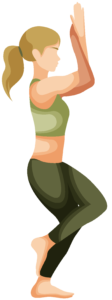Eagle (Garudasana)
Pose Overview
| Common Name | Eagle |
| Traditional Sanskrit Name | Garudasana |
| Sanskrit Name Pronunciation | gah-rue-DAHS-ah-nuh |
| Pose Difficulty | Intermediate |
| Drishti
Drishti is the gaze or visual focus point during yoga poses.
Learn more about Drishti |
Tip of the nose |
Eagle Pose, also known as Garudasana, is a standing balance pose that is often used in intermediate and advanced yoga classes. The name comes from the Hindu mythology figure Garuda, who is a bird-like creature often depicted as an eagle. The pose is said to resemble the powerful yet steady stance of an eagle, with the arms and legs representing its wings and talons. The pose requires a lot of balance, focus, and flexibility, making it a great challenge for intermediate yogis.
Benefits of Eagle
Eagle Pose has many benefits for both the body and mind. Physically, it helps to improve balance, focus, and flexibility, particularly in the legs, hips, and shoulders. It also helps to improve digestion and circulation. Mentally, it helps to improve concentration, focus, and mental clarity.
How to Enter Eagle
Begin in Mountain Pose (Tadasana) Bend your knees slightly and bring your right thigh over your left, crossing them at the knee. Bring your right arm under your left and bring your palms together in front of your chest. Press your elbows into your inner thighs and lift your elbows up towards the ceiling. Gaze forward, keeping your neck and spine in a neutral position. Hold the pose for several breaths, then release and repeat on the other side.
How to Exit Eagle
Release the pose by releasing your arms and legs. Return to Mountain Pose and take a few deep breaths.
Common Eagle Modifications & Variations
If crossing your legs is uncomfortable, you can separate your legs and place the right foot in front of the left. If bringing your palms together is uncomfortable, you can use a strap to bind your arms together. If standing on one foot is difficult, you can stand with both feet on the ground.
Common Mistakes with Eagle
Not crossing the legs or arms enough, which can make the pose less challenging and less effective. Not lifting the elbows up towards the ceiling, which can put unnecessary strain on the shoulders. Not keeping the gaze forward, which can cause the neck and spine to be in an improper position.
Safety Guidance
Make sure to take it slow and only go as deep into the pose as your body allows. If you experience any pain or discomfort, release the pose immediately. If you have any knee or ankle injuries, be cautious with this pose.

